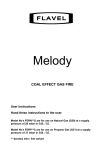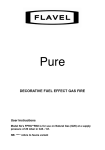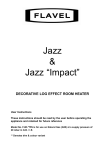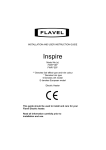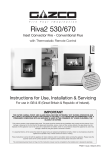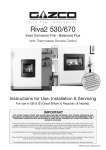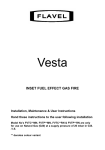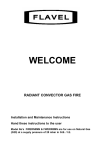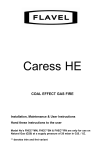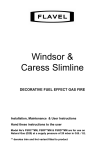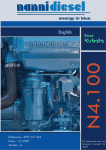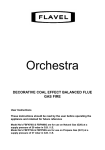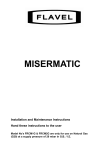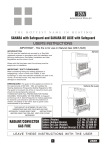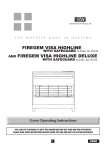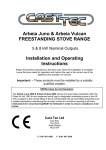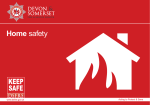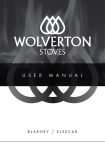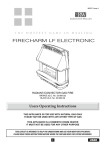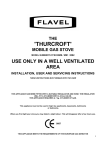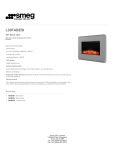Download Emberglow - Direct Fireplaces
Transcript
Emberglow COAL EFFECT BALANCED FLUE GAS FIRE User Instructions These instructions should be read by the user before operating the appliance and retained for future reference Model No. FEBC00MN is only for use on Natural Gas (G20) at a supply pressure of 20 mbar in G.B. / I.E. INSTALLATION INFORMATION CONDITIONS OF INSTALLATION It is the law that all gas appliances are installed only by a competent (e.g. CORGI Registered) Installer in G.B. in accordance with the installation instructions and the Gas Safety (Installation and Use) Regulations 1998 as amended. Failure to install appliances correctly could lead to prosecution. It is in your own interest and that of safety to comply with the law. The fire may be fitted below a combustible shelf provided that the shelf is at least 200mm above the top of the appliance and the depth of the shelf does not exceed 150mm. The fire may be installed below combustible shelves, which exceed 150mm deep providing that the clearance above the fire is increased by 15mm for each 25mm of additional overhang in excess of 150mm. If this appliance is fitted directly on to a wall without the use of a fireplace or surround, soft wall coverings such as wallpaper, blown vinyl etc. could be affected by the heat and may discolour or scorch. This should be considered when installing or decorating. The Model number of this appliance is FEBC00MN and it is manufactured by :BFM Europe Ltd. Trentham Lakes Stoke-on-Trent Staffordshire ST4 4TJ 2 ABOUT YOUR NEW EMBERGLOW GAS FIRE The Flavel Emberglow is a decorative fuel effect balanced flue gas fire that incorporates a unique and highly developed fuel bed which gives the realism of a loose coal layout combined with realistic flames and glow. The use of durable hard ceramic material in the construction of the fuelbed components ensures long and trouble free operation. When first using the new fire a slight smell may be noticed. This is due to small deposits of oil on the firebox, but will soon disappear Please take the time to fully read these instructions as you will then be able to obtain the most effective and safe operation of your fire. DO NOT UNDER ANY CIRCUMSTANCES ATTEMPT TO USE THIS APPLIANCE IF THE GLASS PANEL IS BROKEN OR HAS BEEN REMOVED. IMPORTANT SAFETY INFORMATION WARNING : This appliance has a naked flame and as with all heating appliances a fireguard should be used for the protection of children, the elderly and infirm. Fireguards should conform to B.S. 8423 : 2002 (Fireguards for use with gas heating appliances). Servicing should be carried out annually by a competent person such as a CORGI registered engineer. It is a condition of Flavel Fires guarantee schemes that this is carried out by a competent person i.e a CORGI registered Engineer in accordance with these servicing notes The service should include visually checking the appliance flue terminal for obstructions. The condition of the two piece fuelbed should be checked and if necessary the whole unit’s should be replaced with a genuine replacement set. After any servicing work a gas tightness check and spillage test must always be carried out. Any debris or deposits should be removed from the fuel bed from time to time. This may be carried out by referring to the cleaning section as described later in this book. Only the fuelbed as supplied must be used and complete and genuine replacements must be used. 3 Always keep furniture and combustible materials well clear of the fire and never dry clothing or items either on or near to the fire. Never use aerosols or flammable cleaning products near to the fire when it is in use. The fuel bed remains hot for a considerable period after use and sufficient time should be allowed for the fire to cool before cleaning etc. The fire must only be operated with the fender and canopy supplied and in position. OPERATING THE FIRE This appliance is designed so the pilot burner runs constantly, and the touch control is used to operate the main burner only. The touch control can not be used to light the pilot burner. The pilot burner control and main gas valve are located behind the fender. The control valve features two control knobs, the left hand one to light the pilot, and the right hand one to adjust the heat input to the appliance from high (5.20kW) to low (2.05kW). Fig. 1 below shows the control valve. Fig. 1 Pilot Control Knob Lighting the Pilot Main Burner Control Knob To light the pilot, press the knob in and turn it anticlockwise. (It may be necessary to hold the control knob in for a few seconds to purge air from the pipe). Once gas is available at the pilot, by turning the control knob further anticlockwise the piezo igniter will cause a spark at the pilot to light the pilot burner. Once the pilot burner is lit, hold the control knob depressed for approximately 10 seconds to hold the flame supervision device in. Let the control knob go and the pilot should remain lit, if the pilot goes out repeat the lighting sequence. Turn the control knob to the large flame position, this will allow gas to the main burner section of the control valve. 4 Extinguishing the Pilot The pilot flame can be extinguished by turning the left hand control knob clockwise to the position marked with a circular dot. WHEN TURNING THE FIRE “OFF” PLEASE ENSURE THAT THE CONTROL VALVE IS TURNED TO THE “OFF” POSITION AND THE PILOT FLAME IS EXTINGUISHED. DO NOT LEAVE THE PILOT FLAME ONLY LIT. ENSURE THE ASHPAN COVER IS COOL BEFORE REMOVING. Lighting the Main Burner (Manually) The right hand control knob will be in the off position, denoted by a circular dot. No gas can enter the main burner until this control knob is turned anticlockwise. When this knob is turned anti-clockwise, the main burner will light. The heat input can then be adjusted to any level between maximum heat input (5.20kW) and minimum heat input (2.05kW). Lighting the Main Burner (via the Touch Control) With the pilot burner established it is possible to light the main burner and adjust the gas rate between high and low with the touch control. Press the “up” button to light the main burner and adjust the heat input to the maximum setting. (5.20kW heat input). Press the “down” button to reduce the heat input to the minimum setting (2.05kW heat input). See Fig. 2 below. If you press and hold the “down” button it will reduce the heat input to the minimum (3.5kW heat input) setting, if you keep the button depressed it will turn the main burner off, at this point a clicking noise will be heard from the motor. Fig. 2 “Up” button to increase heat input “Down” button to decrease heat input or turn off main burner NOTE : The touch control does not light the pilot, it only lights the main burner when the pilot flame is established and regulates the heat input between high and low. If the touch control is broken, the fire can still be operated manually, see previous page for details. 5 IMPORTANT : IF THE BURNER IS EXTINGUISHED FOR ANY REASON YOU MUST ENSURE THAT YOU WAIT A FULL FIVE MINUTES BEFORE ATTEMPTING TO RE-LIGHT THE FIRE. CLEANING WARNING : Before attempting any cleaning operation ensure that the fire has been allowed to fully cool. CLEANING THE CANOPY, FENDER AND PAINTED METAL PARTS The canopy and fender fitted to this fire may is cast iron and will therefore retain it’s looks for the life of the fire. Black, Stainless steel or Black painted metal parts should be gently cleaned with a damp cloth. Abrasive cleaners, chemical cleaning agents or any type of polish must never be used as damage to the paint may result. CLEANING THE FUEL BED We do not recommend cleaning the fuelbed other than at annual service intervals. If carbon or soot accumulates on the two piece fuelbed, this should be removed by carefully brushing the fuelbed using a soft brush. For instructions on how to remove the glass panel please see page 7. The one piece fuelbed is made from a form of refractory ceramic fibre and should be handled carefully to avoid generating dust, as this may be harmful if inhaled. As with some fibrous materials, handling fibrous materials without gloves could cause skin irritation. The fuelbed should never be washed or exposed to any cleaning agents or water. Any damaged parts must be replaced by contacting your dealer or telephoning BFM Europe Ltd on the number stated on the rear cover of this book. The fuelbed must only be replaced with a genuine replacement and the fire must never be run with a different fuelbed fitted. The fuelbed must be carefully reassembled as stated in the following section. CLEANING THE GLASS PANEL To clean the glass panel, first ensure that the fire is cool, please note that the glass panel will remain hot for a considerable period when the fire has been switched off. To remove the glass panel, follow the instructions over page for removal and re-fitting. The glass panel should be cleaned gently with a soft damp cloth and glass cleaner. DO NOT UNDER ANY CIRCUMSTANCES ATTEMPT TO CLEAN THE GLASS PANEL WHEN THE APPLIANCE IS RUNNING. 6 REMOVING / RE-FITTING THE GLASS FRAME ASSEMBLY a) The glass frame is held in position by hooking the top flange over the combustion chamber opening at the top as shown in Fig. 3 below. Fig. 3 Glass Frame Assembly locates over lip on top of combustion chamber lid, and drops onto flange as shown. To remove, unclip base clips as shown in Fig. 11 and lift clear. Combustion Chamber denotes correct final position of glass frame. b) The assembly is then secured to the bottom of the combustion chamber by the two hinge clamp brackets as shown below in Fig 4. These are clamped together to form the seal between the glass frame assembly and the combustion chamber. NOTE : Always ensure that a consistent seal between the combustion chamber and the glass frame is achieved. Fig. 4 7 REMOVAL / RE-FITTING OF THE FUELBED NOTE : The position of the fuel-bed components are critical to the performance of the product. Therefore please ensure that the fuel-bed components are positioned as described in the following section prior to requesting a service call due to soot build up, poor flame pattern etc. a) Place the fuel-bed rear section centrally in the combustion chamber as shown below in Fig. 5, ensuring Fig. 5 Retaining brackets for front coal form Retaining brackets for rear coal form b) Fit the front ceramic coal form in front of the burner, as shown below in Fig 6. Ensure that the front ceramic coal form is correctly located behind the retaining brackets at the L/H & R/H ends. Fig. 6 To ensure that the release of fibres from these R.C.F (Refractory Ceramic Fibre) articles is kept to a minimum, during installation and servicing we recommend that you use a HEPA filtered vacuum to remove any dust accumulated in and around the appliance before and after working on the appliance. When replacing these articles we recommend that the replaced items are not broken up, but are sealed within heavy duty polythene bags, clearly labelled as “RCF waste”. RCF waste is classed as a “stable”, non reactive hazardous waste and may be disposed of at a landfill licensed to accept such waste Protective clothing is not required when handling these articles, but we recommend you follow the normal hygiene rules of not smoking, eating or drinking in the work area, and always wash your hands before eating or drinking. Refit the glass frame as detailed in section on page 7, then light the appliance as detailed on page 4 & 5. USER REPLACEABLE PARTS The only user replaceable parts on this fire are the fuelbed / coal form, which may be replaced as described in the previous section. Replacement of any other parts must be carried out by a competent person such as a CORGI registered gas installer. Due to our policy of continual improvement and development the exact accuracy of descriptions and illustrations cannot be guaranteed Part No. B-86720 Issue 5 BFM Europe Ltd. Trentham Lakes Stoke-on-Trent Staffordshire ST4 4TJ Telephone - General Enquiries : Telephone - Service : (01782) 339000 (0844) 7700169












